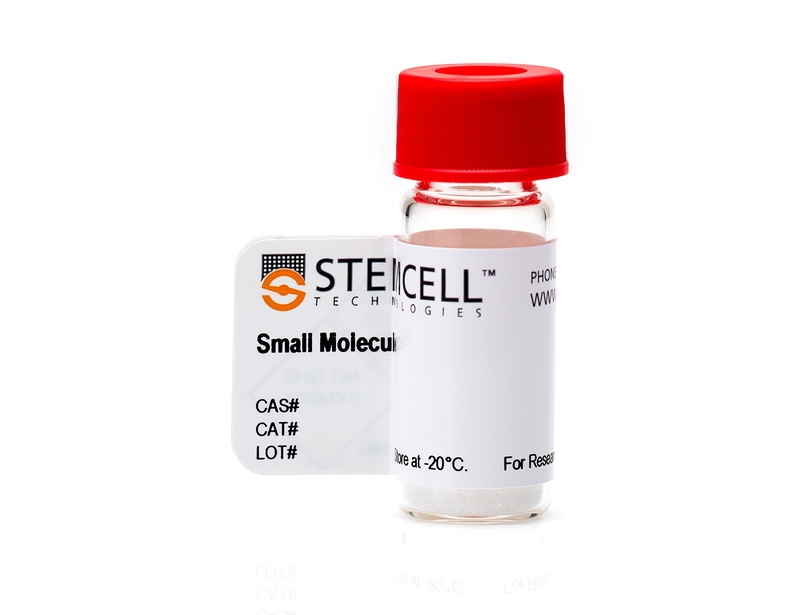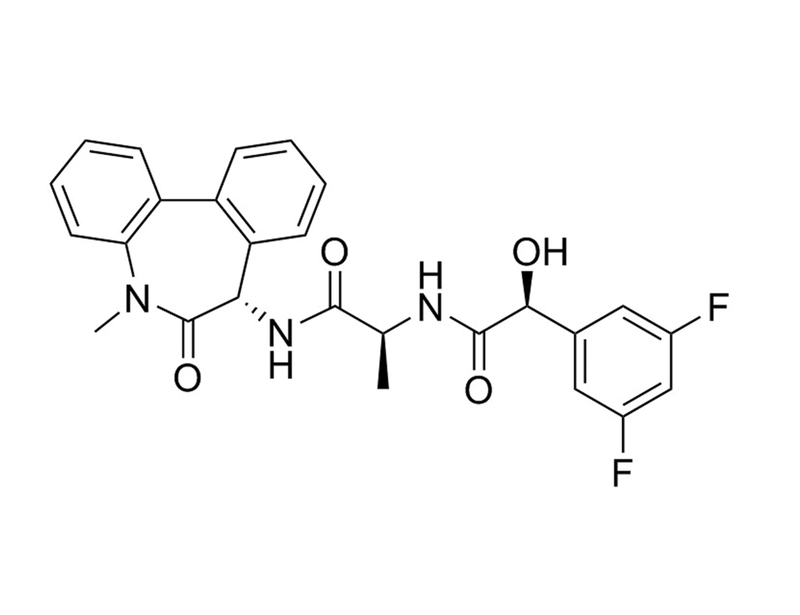LY411575
Notch pathway inhibitor; Inhibits γ-secretase
概要
LY411575 is a cell-permeable γ-secretase inhibitor (IC₅₀ = 0.14 nM) that blocks Notch activation in vitro at 500 µM (Curry et al.; Czirr et al.) via γ-Secretase inhibition. Notch is a transmembrane receptor that plays a key role in cell fate decisions including cell proliferation, differentiation, and apoptosis.
DIFFERENTIATION
· Promotes neuronal differentiation of neural progenitor cells derived from mouse embryonic stem (ES) cells (Abranches et al.; Aranha et al.).
· Promotes goblet cell differentiation in mouse intestine and cultured colonic organoids (Okamoto et al.; Yui et al.).
· Induces hair cell differentiation from inner ear stem cells in vitro, and transdifferentiation of supporting cells into hair cells in vivo (Bramhall et al.; Mizutari et al.).
· Causes premature differentiation of Her4-positive progenitors into neurons in zebrafish (Dirian et al.).
CANCER RESEARCH
· Induces apoptosis in primary and immortalized Karposi’s sarcoma cells (Curry et al.).
DIFFERENTIATION
· Promotes neuronal differentiation of neural progenitor cells derived from mouse embryonic stem (ES) cells (Abranches et al.; Aranha et al.).
· Promotes goblet cell differentiation in mouse intestine and cultured colonic organoids (Okamoto et al.; Yui et al.).
· Induces hair cell differentiation from inner ear stem cells in vitro, and transdifferentiation of supporting cells into hair cells in vivo (Bramhall et al.; Mizutari et al.).
· Causes premature differentiation of Her4-positive progenitors into neurons in zebrafish (Dirian et al.).
CANCER RESEARCH
· Induces apoptosis in primary and immortalized Karposi’s sarcoma cells (Curry et al.).
Alternative Names
Not applicable
Cell Type
Cancer Cells and Cell Lines, Intestinal Cells, Keratinocytes, Neural Cells, PSC-Derived, Neurons
Species
Human, Mouse, Rat, Non-Human Primate, Other
Application
Differentiation, Organoid Culture
Area of Interest
Cancer Research, Epithelial Cell Biology, Neuroscience, Stem Cell Biology
CAS Number
209984-57-6
Chemical Formula
C₂₆H₂₃F₂N₃O₄
Molecular Weight
479.5 g/mol
Purity
≥ 98%
Pathway
Notch
Target
γ-Secretase
技术资料
| Document Type | 产品名称 | Catalog # | Lot # | 语言 |
|---|---|---|---|---|
| Product Information Sheet 1 | LY411575 | 72792, 72794 | All other lots | English |
| Product Information Sheet 2 | LY411575 | 72792, 72794 | SC10766, SC05627, and BX29730 and lower | English |
| Safety Data Sheet | LY411575 | 72792, 72794 | All | English |
数据及文献
Publications (9)
Stem cell reports 2014 MAR
Lgr5-positive supporting cells generate new hair cells in the postnatal cochlea.
Abstract
Abstract
The prevalence of hearing loss after damage to the mammalian cochlea has been thought to be due to a lack of spontaneous regeneration of hair cells, the primary receptor cells for sound. Here, we show that supporting cells, which surround hair cells in the normal cochlear epithelium, differentiate into new hair cells in the neonatal mouse following ototoxic damage. Using lineage tracing, we show that new hair cells, predominantly outer hair cells, arise from Lgr5-expressing inner pillar and third Deiters cells and that new hair cell generation is increased by pharmacological inhibition of Notch. These data suggest that the neonatal mammalian cochlea has some capacity for hair cell regeneration following damage alone and that Lgr5-positive cells act as hair cell progenitors in the cochlea.
Developmental cell 2014 JUL
Spatial regionalization and heterochrony in the formation of adult pallial neural stem cells.
Abstract
Abstract
Little is known on the embryonic origin and related heterogeneity of adult neural stem cells (aNSCs). We use conditional genetic tracing, activated in a global or mosaic fashion by cell type-specific promoters or focal laser uncaging, coupled with gene expression analyses and Notch invalidations, to address this issue in the zebrafish adult telencephalon. We report that the germinal zone of the adult pallium originates from two distinct subtypes of embryonic progenitors and integrates two modes of aNSC formation. Dorsomedial aNSCs derive from the amplification of actively neurogenic radial glia of the embryonic telencephalon. On the contrary, the lateral aNSC population is formed by stepwise addition at the pallial edge from a discrete neuroepithelial progenitor pool of the posterior telencephalic roof, activated at postembryonic stages and persisting lifelong. This dual origin of the pallial germinal zone allows the temporally organized building of pallial territories as a patchwork of juxtaposed compartments.
Neuron 2013 JAN
Notch inhibition induces cochlear hair cell regeneration and recovery of hearing after acoustic trauma.
Abstract
Abstract
Hearing loss due to damage to auditory hair cells is normally irreversible because mammalian hair cells do not regenerate. Here, we show that new hair cells can be induced and can cause partial recovery of hearing in ears damaged by noise trauma, when Notch signaling is inhibited by a γ-secretase inhibitor selected for potency in stimulating hair cell differentiation from inner ear stem cells in vitro. Hair cell generation resulted from an increase in the level of bHLH transcription factor Atoh1 in response to inhibition of Notch signaling. In vivo prospective labeling of Sox2-expressing cells with a Cre-lox system unambiguously demonstrated that hair cell generation resulted from transdifferentiation of supporting cells. Manipulating cell fate of cochlear sensory cells in vivo by pharmacological inhibition of Notch signaling is thus a potential therapeutic approach to the treatment of deafness.
Nature medicine 2012 APR
Functional engraftment of colon epithelium expanded in vitro from a single adult Lgr5 stem cell.
Abstract
Abstract
Adult stem-cell therapy holds promise for the treatment of gastrointestinal diseases. Here we describe methods for long-term expansion of colonic stem cells positive for leucine-rich repeat containing G protein-coupled receptor 5 (Lgr5(+) cells) in culture. To test the transplantability of these cells, we reintroduced cultured GFP(+) colon organoids into superficially damaged mouse colon. The transplanted donor cells readily integrated into the mouse colon, covering the area that lacked epithelium as a result of the introduced damage in recipient mice. At 4 weeks after transplantation, the donor-derived cells constituted a single-layered epithelium, which formed self-renewing crypts that were functionally and histologically normal. Moreover, we observed long-term (textgreater6 months) engraftment with transplantation of organoids derived from a single Lgr5(+) colon stem cell after extensive in vitro expansion. These data show the feasibility of colon stem-cell therapy based on the in vitro expansion of a single adult colonic stem cell.
BMC genomics 2010 JAN
Apoptosis-associated microRNAs are modulated in mouse, rat and human neural differentiation.
Abstract
Abstract
BACKGROUND MicroRNAs (miRs or miRNAs) regulate several biological processes in the cell. However, evidence for miRNAs that control the differentiation program of specific neural cell types has been elusive. Recently, we have shown that apoptosis-associated factors, such as p53 and caspases participate in the differentiation process of mouse neural stem (NS) cells. To identify apoptosis-associated miRNAs that might play a role in neuronal development, we performed global miRNA expression profiling experiments in NS cells. Next, we characterized the expression of proapoptotic miRNAs, including miR-16, let-7a and miR-34a in distinct models of neural differentiation, including mouse embryonic stem cells, PC12 and NT2N cells. In addition, the expression of antiapoptotic miR-19a and 20a was also evaluated. RESULTS The expression of miR-16, let-7a and miR-34a was consistently upregulated in neural differentiation models. In contrast, expression of miR-19a and miR-20a was downregulated in mouse NS cell differentiation. Importantly, differential expression of specific apoptosis-related miRNAs was not associated with increased cell death. Overexpression of miR-34a increased the proportion of postmitotic neurons of mouse NS cells. CONCLUSIONS In conclusion, the identification of miR-16, let-7a and miR-34a, whose expression patterns are conserved in mouse, rat and human neural differentiation, implicates these specific miRNAs in mammalian neuronal development. The results provide new insights into the regulation of neuronal differentiation by apoptosis-associated miRNAs.
American journal of physiology. Gastrointestinal and liver physiology 2009 JAN
Requirement of Notch activation during regeneration of the intestinal epithelia.
Abstract
Abstract
Notch signaling regulates cell differentiation and proliferation, contributing to the maintenance of diverse tissues including the intestinal epithelia. However, its role in tissue regeneration is less understood. Here, we show that Notch signaling is activated in a greater number of intestinal epithelial cells in the inflamed mucosa of colitis. Inhibition of Notch activation in vivo using a gamma-secretase inhibitor resulted in a severe exacerbation of the colitis attributable to the loss of the regenerative response within the epithelial layer. Activation of Notch supported epithelial regeneration by suppressing goblet cell differentiation, but it also promoted cell proliferation, as shown in in vivo and in vitro studies. By utilizing tetracycline-dependent gene expression and microarray analysis, we identified a novel group of genes that are regulated downstream of Notch1 within intestinal epithelial cells, including PLA2G2A, an antimicrobial peptide secreted by Paneth cells. Finally, we show that these functions of activated Notch1 are present in the mucosa of ulcerative colitis, mediating cell proliferation, goblet cell depletion, and ectopic expression of PLA2G2A, thereby contributing to the regeneration of the damaged epithelia. This study showed the critical involvement of Notch signaling during intestinal tissue regeneration, regulating differentiation, proliferation, and antimicrobial response of the epithelial cells. Thus Notch signaling is a key intracellular molecular pathway for the proper reconstruction of the intestinal epithelia.




